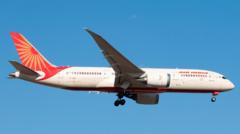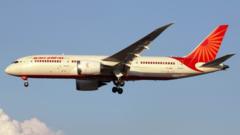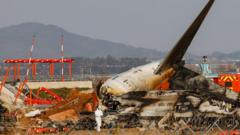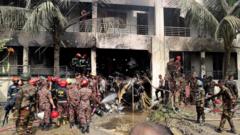The investigation aims to uncover causes as experts analyze data from flight recorders and examine potential mechanical failures.
**Investigation Progresses on Air India Flight 171 Crash**

**Investigation Progresses on Air India Flight 171 Crash**
Authorities delve into the wreckage of Air India’s Boeing 787, seeking answers regarding the rapid descent and crash in Ahmedabad.
---
The tragic crash of Air India Flight 171, which inexplicably went down just moments after take-off from Ahmedabad, has left investigators with the daunting task of piecing together the events that led to one of India's rare aviation disasters. The Boeing 787 was airborne for less than 40 seconds before its demise, prompting a frantic investigation into the cockpit communications and flight data recorders, crucial tools in understanding the calamity. According to international aviation regulations, a preliminary report must be produced within 30 days, while a comprehensive report should ideally follow within a year.
Under the command of Captain Sumeet Sabharwal and co-pilot Clive Kundar, the aircraft was en route to London Gatwick, carrying 242 passengers and approximately 100 tonnes of fuel when it issued a mayday call—its final transmission—before losing altitude and crashing into a student hostel near the airport. This crash, characterized by aviation experts as a “controlled flight into terrain,” poses several questions about potential mechanical malfunctions, pilot actions, or environmental factors at play.
Captain Kishore Chinta, a former investigator with the Aircraft Accident Investigation Bureau (AAIB), voiced his astonishment at the extraordinary circumstances of the crash, noting, “Nothing quite like this has ever happened.” Investigators are exploring possibilities that could have caused the aircraft to crash so quickly, including failures in both engines, issues relating to maintenance procedures, or improper configurations during takeoff. The investigation findings could have implications not only for Air India but also for the Boeing 787 fleet worldwide.
As investigators comb through the wreckage, they are meticulously studying everything from engines to cockpit recordings. Peter Goelz, former managing director of the U.S. National Transportation Safety Board, underscored the importance of analyzing the engines: the damage patterns will help indicate whether they were operational at the time of the impact. Additionally, the aircraft's black boxes—which have reportedly been recovered—will shed light on cockpit activities leading up to the crash.
Experts caution that while the cause of the accident could be discerned fairly quickly, understanding the deeper reasons behind it may take much longer. All elements of the flight, including pilot training records and aircraft maintenance logs, will come under scrutiny, as investigators seek to find any indications of systemic faults or human error.
With over 1,100 Boeing 787s in operation globally, the ramifications of this investigation could extend far beyond just the Air India aircraft. The coming weeks will be critical as officials sift through collected data, revealing crucial insights into the aviation industry's safety protocols and their current efficacy. As technology in aviation investigation advances, investigators have access to a wealth of data that previous generations could not have imagined, suggesting that answers may surface sooner rather than later.
The tragic crash of Air India Flight 171, which inexplicably went down just moments after take-off from Ahmedabad, has left investigators with the daunting task of piecing together the events that led to one of India's rare aviation disasters. The Boeing 787 was airborne for less than 40 seconds before its demise, prompting a frantic investigation into the cockpit communications and flight data recorders, crucial tools in understanding the calamity. According to international aviation regulations, a preliminary report must be produced within 30 days, while a comprehensive report should ideally follow within a year.
Under the command of Captain Sumeet Sabharwal and co-pilot Clive Kundar, the aircraft was en route to London Gatwick, carrying 242 passengers and approximately 100 tonnes of fuel when it issued a mayday call—its final transmission—before losing altitude and crashing into a student hostel near the airport. This crash, characterized by aviation experts as a “controlled flight into terrain,” poses several questions about potential mechanical malfunctions, pilot actions, or environmental factors at play.
Captain Kishore Chinta, a former investigator with the Aircraft Accident Investigation Bureau (AAIB), voiced his astonishment at the extraordinary circumstances of the crash, noting, “Nothing quite like this has ever happened.” Investigators are exploring possibilities that could have caused the aircraft to crash so quickly, including failures in both engines, issues relating to maintenance procedures, or improper configurations during takeoff. The investigation findings could have implications not only for Air India but also for the Boeing 787 fleet worldwide.
As investigators comb through the wreckage, they are meticulously studying everything from engines to cockpit recordings. Peter Goelz, former managing director of the U.S. National Transportation Safety Board, underscored the importance of analyzing the engines: the damage patterns will help indicate whether they were operational at the time of the impact. Additionally, the aircraft's black boxes—which have reportedly been recovered—will shed light on cockpit activities leading up to the crash.
Experts caution that while the cause of the accident could be discerned fairly quickly, understanding the deeper reasons behind it may take much longer. All elements of the flight, including pilot training records and aircraft maintenance logs, will come under scrutiny, as investigators seek to find any indications of systemic faults or human error.
With over 1,100 Boeing 787s in operation globally, the ramifications of this investigation could extend far beyond just the Air India aircraft. The coming weeks will be critical as officials sift through collected data, revealing crucial insights into the aviation industry's safety protocols and their current efficacy. As technology in aviation investigation advances, investigators have access to a wealth of data that previous generations could not have imagined, suggesting that answers may surface sooner rather than later.





















